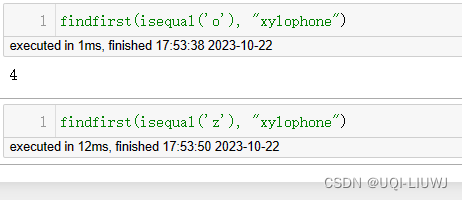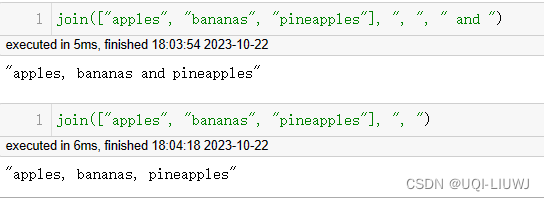-
julia笔记:字符和字符串
1 字符
- Char类型的值代表单个字符
- c='a'
- #'a': ASCII/Unicode U+0061 (category Ll: Letter, lowercase)
- typeof(c)
- #Char
- 将 Char 转换为其对应的整数值,即 Unicode 代码
- c=Int(c)
- c
- #97
- typeof(c)
- #Int64
- 将一个整数值(Unicaode)转回 Char
- Char(97)
- #'a': ASCII/Unicode U+0061 (category Ll: Letter, lowercase)
- 字符也可以进行
- 'A' < 'a'
- #true
- 'A' +1
- #'B': ASCII/Unicode U+0042 (category Lu: Letter, uppercase)
2 字符串
2.1 创建
由双引号或三重双引号分隔
- 双引号 (
") 通常用于定义单行字符串
- str="Hello world"
- str
- # "Hello world"
- 三重双引号 (
""") 可以用于定义多行字符串。- 在这种情况下,可以在一个字符串中包含多行文本,而无需使用明确的换行字符或连接多个单行字符串。
- s = """This is a multiline
- string in Julia."""
- s
- #"This is a multiline\nstring in Julia."
- 当需要在字符串中包含双引号等转义字符时,使用三重双引号可以更加方便,因为你不需要转义内部的双引号
- s = """He said, "Hello, Julia!" without any issues."""
- s
- #"He said, \"Hello, Julia!\" without any issues."
- 在字符串中,如果一行内容太长,可以在换行之前加上反斜杠 (
\) 来将其分割。- 使用反斜杠后,实际的字符串内容不会包含换行符
- 这样可以使代码更易读,同时不改变字符串的实际内容。
- str="Hello \
- world"
- str
- #"Hello world"
2.2 索引
可以使用数字(索引从1开始),也可以是begin和end(他们俩可以视作普通值,可以直接在上面进行计算)
- str="Hello world"
- str
- #"Hello world"
- str[begin]
- #'H': ASCII/Unicode U+0048 (category Lu: Letter, uppercase)
- str[1]
- #'H': ASCII/Unicode U+0048 (category Lu: Letter, uppercase)
- str[end]
- #'d': ASCII/Unicode U+0064 (category Ll: Letter, lowercase)
- str[begin*3]
- #'l': ASCII/Unicode U+006C (category Ll: Letter, lowercase)
- 使用小于 begin (1) 或大于 end 的索引会引发错误:
- str[begin-1]
- '''
- BoundsError: attempt to access 11-codeunit String at index [0]
- Stacktrace:
- [1] checkbounds
- @ .\strings\basic.jl:216 [inlined]
- [2] codeunit
- @ .\strings\string.jl:117 [inlined]
- [3] getindex(s::String, i::Int64)
- @ Base .\strings\string.jl:238
- [4] top-level scope
- @ In[48]:1
- '''
- str[end+1]
- '''
- BoundsError: attempt to access 11-codeunit String at index [12]
- Stacktrace:
- [1] checkbounds
- @ .\strings\basic.jl:216 [inlined]
- [2] codeunit
- @ .\strings\string.jl:117 [inlined]
- [3] getindex(s::String, i::Int64)
- @ Base .\strings\string.jl:238
- [4] top-level scope
- @ In[49]:1
- '''
- 可以使用范围索引来提取字符串(左闭右闭)
- str[3:4]
- #"ll"
- 表达式 str[k] 和 str[k:k] 不会给出相同的结果:
- 前者是一个
Char类型的单个字符,而后者是一个恰好只包含一个字符的字符串
- 前者是一个
2.3 拼接
- 使用string拼接
- greet = "Hello"
- whom = "world"
- string(greet, ", ", whom, ".\n")
- #"Hello, world.\n"
- 也使用*用于字符串级联
- greet = "Hello"
- whom = "world"
- greet * ", " * whom * ".\n"
- #"Hello, world.\n"
- 使用$插值进行拼接
- greet = "Hello"
- whom = "world"
- "$greet, $whom.\n"
2.4 其他方法
-
相关阅读:
用 Python 绘制动态可视化图表,太酷了
使用Apache Flink 和 Apache Hudi 创建低延迟数据湖管道
基于Python3搭建qt开发环境
C++ day1
图文解释各种电阻阻值的读取方法【硬件篇】
linux中git暂存,提交,上传到github
SpringCloud Ribbon--负载均衡 原理及应用实例
【1106】记录
筋膜枪控制、驱动方案推荐:有感方波、无感方波控制
【Unity】2D角色跳跃控制器
- 原文地址:https://blog.csdn.net/qq_40206371/article/details/133974706







